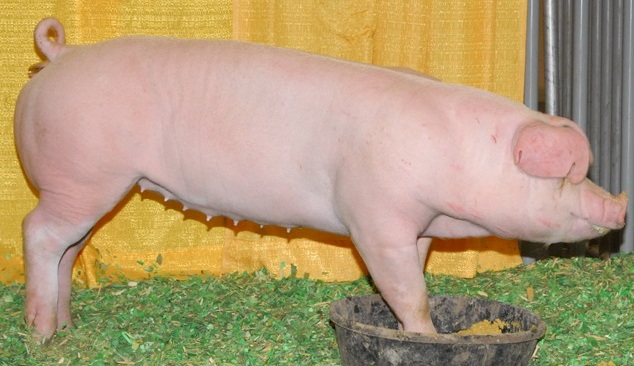SWINE HUSBANDRY
India has a population of about million pigs, which is less than 1 % world population. Even in the present undeveloped state they contribute pork and bristles, a valuable export commodity. Though pigs are maintained for production of pork, their role in progressive agriculture is not fully recognized. Pig farming is adapted to both diversified and intensified agriculture. Pigs convert inedible feeds, forages, and certain grain byproducts obtained from mills, meat by products, damaged feeds and garbage into valuable nutrition’s mean. The faeces of pigs are useful in maintaining soil fertility.
The pig grow fast and is a prolific breeder, farrowing 10-12 piglets at a time. It is capable of producing two litters per year under good management conditions. The carcase yield is high : 65 -80% of live weight. With a small investment on building and equipment, proper feeding and sound disease control program the farmer can profitably utilize his time and labour in this subsidiary occupation.
SELECTION OF BREEDS
- For commercial pig farming upgraded / crossbred or exotic stock in good health should be selected.
- While selecting a gilt or sow primary aim should be to secure a female that will produce large survivable litter and which can attain marketable weight at an age of six months or less.
- Animals those are ready to be bred should be selected.
- Identify the newly purchased animal by giving suitable identification mark (ear notching or tattooing).
- Vaccinate the animals against diseases.
- Keep the animal under observations for a period of about two weeks and then mix with the other animals.
- Purchase animals in two batches at the interval of three months.
- Follow judicious culling and replacement of animals in a herd.
- Cull the old animals after 10-12 farrowings.
( Source: www.vuatkerala.org )
Breeding Boars
Selection
The following are the important criteria for selection of boars for breeding purposes.
- They must be offspring of better producing gilts and sows.
- They must belong to a litter with size and weight of not less than 8 and 72 kg respectively at weaning.
- Boars satisfying above stipulations are subjected to preliminary selection at 5 months of age provided they have a body weight of at least 60 kg.
- Final selection of boars should be undertaken at 7 months provided it has attained a body weight of at least 90 kg.
- Must be free from physical defects.
- Breeding males and females should be selected from different litters and boars should be changed periodically – preferably once in two years – for avoiding inbreeding.
.jpg)
Breeding Boar
Modern and well-established scientific principles, practices and skills should be used to obtain maximum economic benefits from pig farming.
Management of boars
- Boars should be fed after service rather than before.
- Boar: sow ratio may be 1:25.
- Outdoor exercise is good for keeping the boar thrifty and virile. He should neither be over fat nor run down. The boar may be handled firmly but gently, keeping in mind that he can be dangerous.
- Each boar should be housed separately.
- Number of services for boars: 2 - 4 per week depending on the age of boar.
- Boars should be tested for brucellosis and leptospirosis periodically.
Breeding Females
Selection
Gilts: Breeding pigs are selected from mother pigs having good mothering ability as shown by large litter size and weight at weaning. Gilts should have 12-14 evenly spaced sound teats, good growth rate and feminity.

Gilt
Weaned sows: Sows are usually weaned at 8 weeks after farrowing. The weaned sows come into heat in 3-10 days after weaning. They may be bred on the first post-weaning heat itself since this period is most fertile. She may respond to nutritious diet and pick up fast if the condition is poor.
Pregnant sows and gilts: In addition to having proper nutrition, the pregnant animals should be provided with regular exercise. Forced exercise may be brought about by feeding some distance away from the house or inducing the animal for moderate walk. Sows of the same size and condition can be run together. The bred and gilts may be housed separately. Do not house boars along with pregnant stock. Avoid overcrowding, mixing of new and old stock, slippery ground and overexciting of pregnant pigs.
The advantages of the pig farming are:
- The pig can utilize wide variety of feed stuffs viz. grains, forages, damaged feeds and garbage and convert them into valuable nutritious meat. However, feeding of damaged grains, garbage and other unbalanced rations may result in lower feed efficiency.
- They are prolific with shorter generation interval. A sow can be bred as early as 8-9 months of age and can farrow twice in a year. They produce 6-12 piglets in each farrowing.
- Pig farming requires small investment on buildings and equipments
- Pigs are known for their meat yield, which in terms of dressing percentage ranges from 65 - 80 in comparison to other livestock species whose dressing yields may not exceed 65%.
- Pork is most nutritious with high fat and low water content and has got better energy value than that of other meats. It is rich in vitamins like thiamin, Niacin and riboflavin.
- Pigs manure is widely used as fertilizer for agriculture farms and fish ponds.
- Pigs store fat rapidly for which there is an increasing demand from poultry feed, soap, paints and other chemical industries.
- Pig farming provides quick returns since the marketable weight of fatteners can be achieved with in a period of 6-8 months.
- There is good demand from domestic as well as export market for pig products such as pork, bacon, ham, sausages, lard etc.
(Source: www.vuatkerela.org )
|

.jpg)
